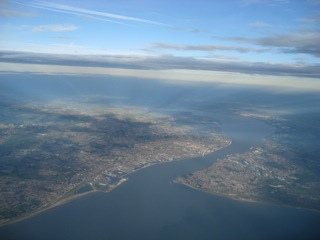Flying Boy Across the Mersey? December 16, 2013
Author: Beach Combing | in : Modern , trackbackThis interesting but very confusing passage comes from Aubrey’s wonderful Brief Lives. It is, more specifically, from the chapter on a Lancastrian mathematician named Jonas Moore who had been taught by one William Gascoigne (this becomes important). Aubrey includes several fascinating facts including the unforgettable sentence that: ‘Sciatica: [Sir Jonas] cured it by boiling his buttock.’ But what about this little paragraph that seems to have been missed from most of the early histories of flight? Possibly because it is difficult to understand: Aubrey at his short-hand worst.
I remember Sir Jonas told us that a Jesuit (I think ’twas Grenbergerus of the Roman College) found out a way of flying, and that he made a youth perform it. Mr Gascoigne taught an Irish boy the way, and he flew over a river in Lancashire (or thereabouts), but when he was up in the air, the people gave a shout, whereat the boy being frightened, he fell down on the other side of the river, and broke his legs, and when he came to himself, he said that he thought the people had seen some strange apparition, which fancy amazed him. This was in 1635, and he [Gascoigne?] spoke [about] it in the Royal Society, upon the account of the flying at Paris two years since. See the Transactions.
This passage needs to be paired down. Is there one or two accounts of young men flying? It seems two: Grenbergerus got a young man to fly at the Roman College (the Collegio Romano in Rome?) and Jonas’ old teacher William Gascoigne did the same in Lancashire over a large river. Note that Gascoigne had been brought up in Rome by the Jesuits so there is a link.
The Lancashire river was perhaps the Mersey – see image? There just aren’t that many impressive rivers in the County Palatine. The Irish boy – the Catholic connection again? – fell and broke his legs, a common punishment for those who dare to take to the sky in these early myths: there is a Norman and a South African account that details the injuries done to pioneer fliers.
Beach can make no sense of that final sentence: ‘when he came to himself, he said that he thought the people had seen some strange apparition, which fancy amazed him.’ Is this the boy denying that he had actually flew and saying that the crowds had imagined it? Drbeachcombing AT yahoo DOT com
The flight in Lancashire had, in any case, taken place in, it is alleged, 1635 and Sir Jonas (or Gascoigne?) had supposedly talked about the event in the Royal Society in relation to flying in France. Is this a reference to flying rumours from Paris in the 1640s? This seems though a little bit too early?
18 Dec 2013: Borky writes: Perhaps but me own sense of it’s based on “when he came to” an’ “which fancy amazed him” ie when he regained consciousness he’d lost all memory of ever having been involved in an attempt to effect flight. Thanks Borky!



